 Have you ever wondered how religious movements get started? To learn how, you may be tempted to seek out a magnetic preacher—someone with qualities like the Apostle Paul, John Donne, or Billy Graham. That, however, could be the wrong kind of a person, argues Malcolm Gladwell, a staff writer for The New Yorker, in The Tipping Point. To spread a new religious idea, a better model might be the contagious power of an epidemic rather than that of an individual, however powerful his or her preaching, because to get the job done you need someone skilled in the uses of group power.
Have you ever wondered how religious movements get started? To learn how, you may be tempted to seek out a magnetic preacher—someone with qualities like the Apostle Paul, John Donne, or Billy Graham. That, however, could be the wrong kind of a person, argues Malcolm Gladwell, a staff writer for The New Yorker, in The Tipping Point. To spread a new religious idea, a better model might be the contagious power of an epidemic rather than that of an individual, however powerful his or her preaching, because to get the job done you need someone skilled in the uses of group power.
To make this point, Gladwell cites the historical example of Methodism’s rapid spread in England and North America in the late eighteenth and early nineteenth centuries. The movement’s “tipping point”—when it took on the character of an epidemic—came quite suddenly in the 1780s, when Methodism’s American followers “tipped” from 20,000 to 90,000.
Gladwell writes that the movement’s founder, John Wesley, was not a particularly charismatic preacher—certainly not in a class with his contemporary, George Whitfield, “an orator of such power and charisma that, it was said, he once charmed a five-pound contribution out of Benjamin Franklin—who was, of course, the furthest thing from a churchgoer.”
Nor was Wesley a great theologian, at least not in the tradition of a Calvin or a Luther. His genius was organizational. True, his open-air sermons around England and North America exposed him to thousands of people. “But he didn’t just preach. He also stayed long enough in each town to form the most enthusiastic of his converts into religious societies, which in turn he subdivided into smaller groups of a dozen or so people.”
Converts had to attend weekly meetings and adhere to a strict code of conduct, writes Gladwell, and if they failed to live up to Methodist standards, they were expelled from the group.
“This was a group, in other words, that stood for something. Over the course of his life, Wesley traveled ceaselessly among these groups, covering as much as 4,000 miles a year by horseback, reinforcing the tenets of Methodist belief.”
Gladwell calls Wesley “a classic Connector”—not someone with ties to many other people, but “one person with ties to many groups, which is a small but critical distinction.
“Wesley realized that if you wanted to bring about a fundamental change in people’s belief and behavior, a change that would persist and serve as an example to others, you needed to create a community around them, where those new beliefs could be practiced and expressed and nurtured.”
In this book, which Gladwell, a former newspaper science writer, calls the “biography of an idea,” the writer turns epidemiology (a public-health discipline concerned with the spread of disease) into a tool to examine all sorts of social phenomena.
Gladwell thinks the epidemic is the best way to understand any number of mysterious changes in everyday life. “Ideas and products and messages and behaviors spread just like viruses do,” he writes; but to use the epidemic to explain the world requires introducing into our thinking the notion of contagion, the idea that little changes can have big effects and that change seldom occurs gradually, but, progressing geometrically, gathers strength and then bursts upon us, in a single dramatic instant. Gladwell calls that moment in an epidemic the “tipping point.”
The ideas are interesting, the interventions uncomplicated, and useful too; so that educators, parents, business people, and marketers can deliberately start and control positive epidemics of their own, just as John Wesley did in the 1780s.
However, to be successful, the would-be creators of social epidemics must “understand that human communication has its own set of very unusual and counterintuitive rules.”
In the end, Gladwell writes, “tipping points are a reaffirmation of the potential for change and the power of intelligent action. Look at the world around you. It may seem like an immovable, implacable place. It is not. With the slightest push—in just the right place—it can be tipped.”
Appetizer
A critic looking at these tightly focused, targeted interventions might dismiss them as Band-Aid solutions. But that phrase should not be considered a term of disparagement. The Band-Aid is an inexpensive, convenient, and remarkably versatile solution to an astonishing array of problems. In their history, Band-Aids have probably allowed millions of people to keep working or playing tennis or cooking or walking when they would otherwise have had to stop. The Band-Aid solution is actually the best kind of solution because it involves solving a problem with the minimum amount of effort, time and cost.




























